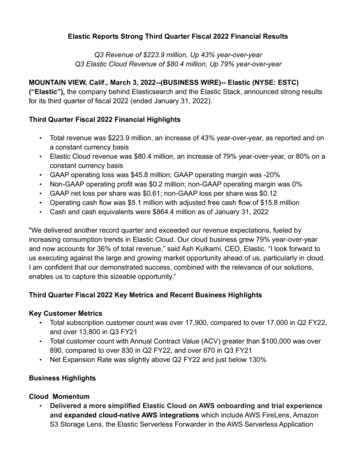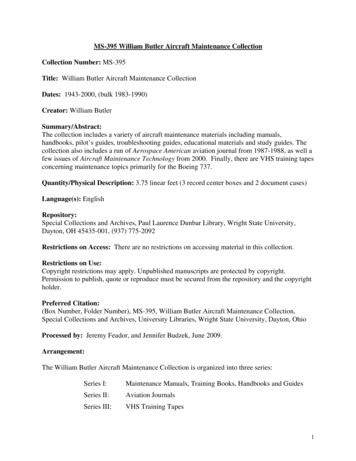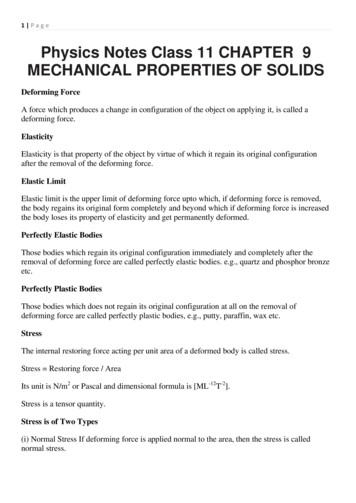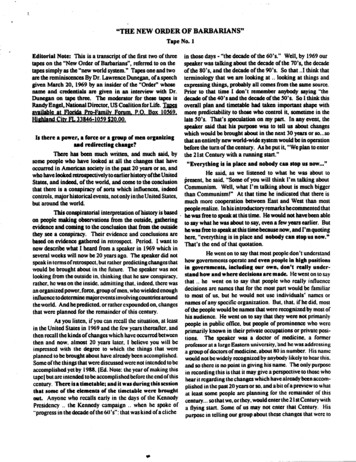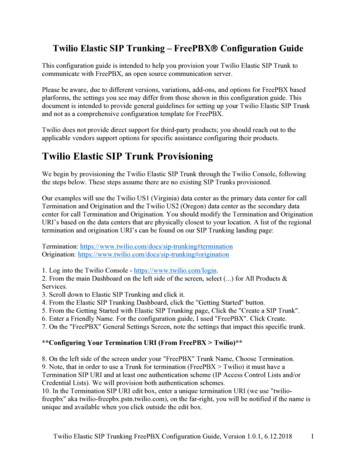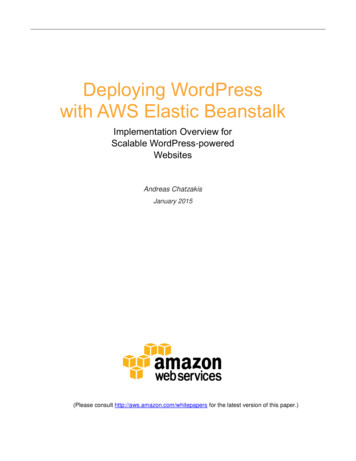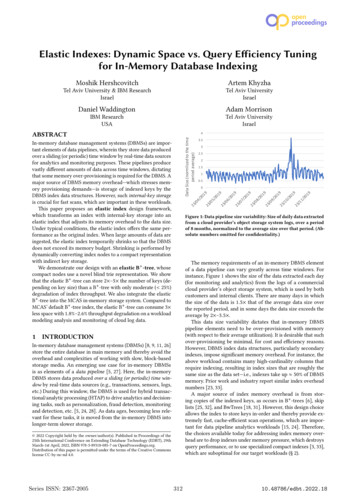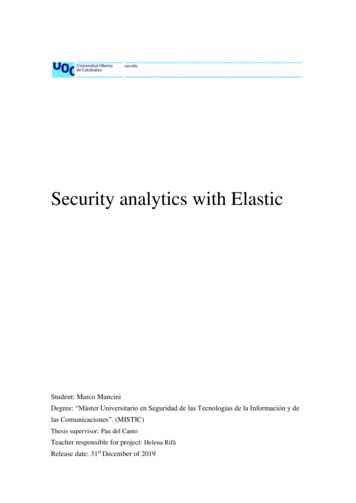
Transcription
Case ReportUse of Elastic Tapes in Presurgical NasoalveolarMolding: A Case ReportDerya Germeç Çakan, DDS, PhD;1,* Simge Diren, DDS, PhD;1,2 and R. Burcu Nur, DDS, PhD3ABSTRACTObjective: One of the objectives of presurgical nasoalveolar molding (PNAM) is to bring the lips together in order to decrease theseverity of the deformity before surgery. This case report aims to present PNAM therapy of an infant with bilateral cleft lip andprimary palate using prefabricated elastic tapes.Materials and Method: A 3-day-old baby girl with bilateral cleft lip and alveolus was referred to our clinic. Her extraoralexamination revealed a deviated and protruded premaxilla, a deficient columella, a short prolabium, depressed alar cartilages,and separated lip segments. A PNAM appliance combined with dynamic tapes (DynaCleft, Canica Design Inc, Ontario, Canada)was delivered the same day.Results: After 3 months of PNAM therapy the premaxillary deviation was corrected, the columella and prolabium werelengthened, and projection and symmetry of the nose were obtained. The horizontal elastic tapes decreased the muscle tensionand brought the lips together.Conclusion: Dynamic bands are very effective because of the active force derived from their elastic components and thus canbe recommended during PNAM therapy as an alternative to conventional tapes. (Turkish J Orthod 2014;27:34–38)KEY WORDS: nasoalveolar molding, prefabricated dynamic tapesINTRODUCTIONCleft lip and palate is the most common congenitalcraniofacial malformation; it is seen in approximately1/700 births and requires care from multiple professionals to optimize the treatment outcomes.1 Theorthodontic discipline has been part of this interdisciplinary team from the start, delivering presurgicaland postsurgical orthopedic and orthodontic treatments.Numerous techniques have been documented asmodern presurgical infant orthopedic treatments,beginning with McNeil2 in 1950, followed by Georgiade and Latham,3 Hotz et al.,4 Matsuo et al.,5 andNakajima et al.6 In 1993, Grayson et al.7 describedpresurgical nasoalveolar molding (PNAM), whichaddresses not only the alveolus but also the lip andthe nose. For patients with bilateral cleft lip andpalate, this technique involves actively molding andrepositioning the alveolar processes, retracting andcentering the premaxilla, approximating the lipsegments, elongating the columella, improving the1Associate Professor, Yeditepe University, School of Dentistry, Department of Orthodontics, Istanbul, Turkey2Private Practice, Istanbul, Turkey3Teaching Assistant, Yeditepe University, School of Dentistry, Department of Orthodontics, Istanbul, Turkey34nasal tip projection by modifying the plate, and useof nasal stents and tapes. The adhesive tapesactively bring the lip segments closer.8 However, thetraditional tapes used for this purpose can becontaminated by such fluids as saliva or milk andadhesion may be weakened by a baby’s orofacialfunctions, which necessitates frequent changes ofthe tape, which can cause skin irritations. Dynamictapes can be used to overcome these side effects.Prefabricated dynamic tapes, which have elasticparts, apply constant force without being affected byoral functions; therefore, they only need to bereplaced every 3 to 4 days.9This case report aims to present the PNAMtherapy of an infant with bilateral cleft lip and primarypalate using prefabricated elastic tapes.*Corresponding author: Derya Germeç Çakan, YeditepeÜniversitesi, Bağdat Cad. No: 238, 34728 Göztepe, İstanbul,Türkiye. E-mail: dgermec@gmail.comTo cite this article: Çakan D, Diren S, Nur RB. Use of elastictapes in presurgical nasoalveolar molding: a case report.Turkish J Orthod. 2014;27:34–38. (DOI: http://dx.doi.org/10.13076/TJO-D-14-00012)Date Submitted: March 2014. Date Accepted: April 2014.Copyright 2014 by Turkish Orthodontic Society
NASOALVEOLAR MOLDING WITH ELASTIC TAPES35Figure 1. Initial photographs. Note the premaxillary deviation, short columella and prolabium. (a) Frontal view. (b) Right lateralview. (c) Left lateral view. (d) Columellar view. (e) Nasal view. (f) Intraoral view.CASE REPORTA 3-day-old baby girl with bilateral cleft lip andalveolus was referred to our cleft clinic. Her clinicalexamination revealed a deviated and protrudedpremaxilla, a deficient and deviated columella, ashort prolabium, insufficient nasal projection, depressed alar cartilages, and separated lip segments(Fig. 1a through f). Intraoral and extraoral impressions were taken.At the same appointment, an acrylic molding platewas fabricated. Bilateral surgical tapes (Steri-Strip,3M Health Care, Neuss, Germany) were appliedextraorally to the cheeks from the retention arms.The parents were advised to use the plate 24 hoursper day except for when cleaning after feeding. Thepatient was monitored weekly. The PNAM plate wasmodified through selective addition and removal ofacrylic to reduce the alveolar gap. In order to bringthe lip segments closer, prefabricated dynamic tapes(DynaCleft, Dynamic Cleft Approximation, CanicaDesign Inc, Almonte, Ontario, Canada), instead ofconventional surgical tapes, were applied horizontally beginning at the second visit until the end ofPNAM therapy (Fig. 2a through d). The parents wereinstructed to apply the tapes on the left side first andthen pull all the way across the face to the right sideto bring the prolabium and columella to the midline.In the second week, nasal cartilage molding wasstarted by adding nasal stents. The bilateral nasalstents were bent from 0.8-mm stainless steel wire inthe form of a swan neck and were kept close tocreate a desired columella of appropriate width in amanner identical to the protocol of Grayson et al.8and Grayson and Maull.10 The circumference ofneck of the stents was covered with a thin hardacrylic layer to increase endurance and then with asoft acrylic layer to prevent irritation. Lengthening ofthe columella and enhancement of the nasal tipprojection were achieved by adding soft acrylic overthe nasal stents weekly. The nasal stents wereconnected to each other by an acrylic bridge at thesixth week of PNAM therapy.Turkish J Orthod Vol 27, No 1, 2014
36Çakan, Diren, and NurFigure 2. Application of prefabricated dynamic tapes during nasoalveolar molding. Note the nasal stents were added to moldthe nasal cartilages. (a) Frontal view. (b). Right lateral view. (c) Left lateral view. (d) Nasal view.After 3 months of PNAM therapy the premaxillarydeviation was corrected, the short columella waslengthened, and the projection and symmetry of thenose were achieved (Fig. 3a through e). Thehorizontally applied elastic tapes brought the lipscloser by decreasing muscle tension. The primarysurgery was performed in the third month.DISCUSSIONThe main objective of PNAM is to reduce theseverity of the initial cleft deformity. A milderdeformity and a precisely defined nasolabial complex, including hard and soft tissues, enables thesurgeon to operate under less tissue tension andresults in a finer surgical scar. Therefore, it is arguedthat the surgical morbidity risks are decreased andthe costs of secondary scar operations are elimated.8Taping the lip segments together across the cleftis one of the most important but sometimesneglected steps in the PNAM protocol. Lip tapingnot only approximates the lips but also enhances theTurkish J Orthod Vol 27, No 1, 2014PNAM effect, producing the desired movements ofthe alveolar segments and the nasal base regions asmentioned by Grayson et al.10 In addition, thedeviated columella can be brought toward themidfacial plane to achieve acceptable symmetry ofthe nostrils, and the protruded premaxilla can beretracted by properly directed lip taping that exertsconstant force.Lip taping is not a new concept; it began beforethe introduction of the modern school of neonatalmaxillary orthopedic treatments. In fact, taping of theface and application of adhesive tapes to narrow thecleft before surgery was used centuries ago.11Moreover, some authors argue that preoperative liptaping eliminates the need for initial orthodontics inall patients except those born with maxillary collapse.12 In the present case, we used the PNAMprocedure because the patient required columellarelongation and correction of premaxillary deviationand protrusion.Another alternative to taping for narrowing the cleftand approximating the lips is use of the lip adhesiontechnique before definitive surgery. Although lip
NASOALVEOLAR MOLDING WITH ELASTIC TAPES37Figure 3. Photographs after presurgical nasoalveolar molding therapy. Note the correction of premaxillary deviation, elongationof the columella and prolabium. (a) Frontal view. (b) Right lateral view. (c) Left lateral view. (d) Columellar view. (e) Intraoral view.taping provides some of the benefits of surgical lipadhesion without the associated surgical morbidity,hospital admission, cost, and scarring, as mentionedby Grayson et al.,8 it is neither easy nor comfortablefor the parents and the infant. The strips are affectedby sweating and may be contaminated by milk orsaliva or by a baby’s orofacial functions, all of whichmay weaken the adhesion between the skin and thetapes. As a result, the ideal light and constant forcecannot be achieved. To overcome these problems,more frequent changing of the tapes may be advisedduring the day, or skin-friendly tapes with a lighteradhesion capacity can be used.Prefabricated dynamic tapes are developed toguide the tissues into a more anatomically normalposition by producing the desired constant force.The tapes have an elastic center, which flexesduring oral functions and returns to its initialdimensions afterward. In this way, the deliveredforce from the tapes to the separated cleft segmentsis constant, which can enhance the successfulapproximation of the lip and alveolar segments.Dynamic tapes can be used alone or in conjunctionwith PNAM (plate þ nasal stents) as presented inthis case report. In addition, they can be combinedwith nasal stents attached to the forehead.9 Thesedynamic tapes, described as skin friendly by themanufacturer, did not cause any skin irritation in ourpatient. Furthermore, the parents mentioned thatthese tapes were easy and fast to apply and couldbe left on the skin approximately 2–3 days withoutloosening. The strong adhesion of the tapes to thecheeks and prolabium is what enables the durability;however, this strong adhesion can be a disadvantage during removal. Therefore, we advise parentsTurkish J Orthod Vol 27, No 1, 2014
38Çakan, Diren, and Nurto use a moisturizing cream or oil before removingthe tapes.3. Georgiade N, Latham R. Maxillary arch alignment in thebilateral cleft lip and palate infant, using pinned coaxialscrew appliance. Plast Reconstr Surg. 1975;56:52–60.CONCLUSION4. Hotz M, Perko M, Gnoinski W. Early orthopaedic stabilization of the praemaxilla in complete bilateral cleft lip andpalate in combination with the Celesnik lip repair. Scand JPlast Reconstr Surg Hand Surg. 1987;21:45–51.Parents are active participants in PNAM therapy,and use of this therapy shows how satisfactoryresults can be achieved when the parents areinformed about what they have to do betweenphysician visits and when attention is paid to theircomplaints. One of the most stressful steps forparents is applying and maintaining the tapes. Liptapes must deliver constant force, ideally 24 hoursper day, to produce the desired molding effects;however, oral functions such as feeding, crying, oreven smiling may weaken the adhesion between theskin and tape. Therefore, use of a type of tape that isnot affected by motions of the mouth can decreasethe number of tape changes and increase thecomfort of the baby and the parents. The prefabricated dynamic tapes described here can be recommended as an alternative to conventional surgicaltapes in PNAM therapy because of the active forcedelivered from its elastic component and ease ofuse.REFERENCES5. Matsuo K, Hirsoe T, Otagiri T, Norose N. Repair of cleft lipwith nonsurgical correction of nasal deformity in the earlyneonatal period. Plast Reconstr Surg. 1989;83:25–31.6. Nakajima T, Yoshimura Y, Sakakibara A. Augmentation ofthe nostril splint for retaining the corrected contour of thecleft lip nose. Plast Reconstr Surg. 1990;85:182–186.7. Grayson B, Cutting C, Wood R. Preoperative columellalengthening in bilateral cleft lip and palate. Plast ReconstrSurg. 1993;92:1422–1423.8. Grayson BH, Santiago PE, Brecht LE, Cutting CB.Presurgical nasoalveolar molding in infants born with cleftsof the lip, alveolus, and palate. Cleft Palate Craniofac J.1999;36:486–498.9. Monasterio L, Ford A, Gutierrez C, Tastes ME, Garcia J.Comparative study of nasoalveolar molding methods: nasalelevator plus Dynacleftt versus NAM-Grayson in patientswith complete unilateral cleft lip and palate. Cleft PalateCraniofac J. 2013;50:548–554.10. Grayson B, Maull D. Nasoalveolar molding for infants bornwith clefts of the lip, alveolus, and palate. Semin Plast Surg.2005;19:294–301.1. Olasoji HO, Ukiri OE, Yahaya A. Incidence and aetiology oforal clefts: a review. Afr J Med Sci. 2005;3(1):1–7.11. Berkowitz S. Cleft Lip and Palate: Diagnosis and Management. 2nd ed. Berlin, Germany: Springer Verlag; 2006.2. McNeil C. Orthodontic procedures in the treatment ofcongenital cleft palate. Dent Rec. 1950;70:126–132.12. Pool R, Farnwoth TK. Preoperative lip taping in cleft lip. AnnPlast Surg. 1994;32:243–249.Turkish J Orthod Vol 27, No 1, 2014
A PNAM appliance combined with dynamic tapes (DynaCleft, Canica Design Inc, Ontario, Canada) was delivered the same day. Results: After 3 months of PNAM therapy the premaxillary deviation was corrected, the columella and prolabium were lengthened, and projection and symmetry of the nose were obtained. The horizontal elastic tapes decreased the .
